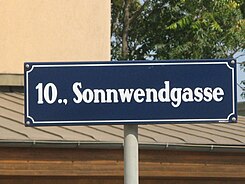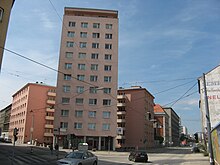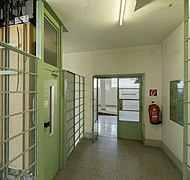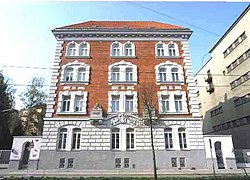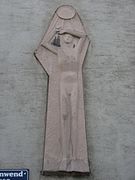Sonnwendgasse
| Sonnwendgasse | |
|---|---|
| Street in Vienna | |
| Basic data | |
| place | Vienna |
| District | Favoriten (10th district) |
| Created | 19th century |
| Cross streets | Favoritenstrasse , Johannitergasse, Mannhartgasse, Reisingergasse, Gertrude-Fröhlich-Sandner-Strasse, Humboldtgasse , Rieplstrasse, Landgutgasse, Alfred-Adler-Strasse, Raaber-Bahn-Gasse, Vally-Weigl-Gasse, Keplergasse, Hackergasse, Ordengasse, Antonie-Alt- Alley, Gudrunstrasse |
| Places | At the Central station |
| Buildings | Central station , main fire station Favoriten |
| use | |
| User groups | Car traffic , bicycle traffic , pedestrians , bus route 69A |
| Technical specifications | |
| Street length | approx. 945 m |
The Sonnwendgasse located in the 10th Vienna district , favorites . It was named in 1864 (at that time still part of Vienna's 4th district of Wieden ) after the solstice celebrations held on June 21st . In 1870 there was an extension. Since 1874 Sonnwendgasse has belonged to the then newly created 10th district.
Location and characteristics
Sonnwendgasse runs in the immediate vicinity of the new main station , which was partially opened in 2012 and completely opened in 2015, and the former Südbahnhof area , which has been redesigned into two new districts since 2010, the Quartier Belvedere north and the Sonnwendviertel south of Alfred-Adler-Strasse.
The Sonnwendgasse begins near the northern district border of Favoritens on Favoritenstraße at the route of the southern railway crossing the street . The new Vienna Central Station was built there directly east of the alley since 2009. From there, Gertrude-Fröhlich-Sandner-Strasse and Alfred-Adler-Strasse , which cross under the new train station, flow into Sonnwendgasse. From the main station it runs in a south-easterly direction, before it turns south after the confluence of Landgutgasse and Alfred-Adler-Straße and ends with a square-like, leafy extension at the east-west connection Gudrunstraße .
The alley is part of the diversion around the Favoritenstraße , which is designed as a pedestrian zone there , which is only accessible for through traffic in Favoriten from Reumannplatz southwards. In addition, a bike path runs alongside the road over the entire length of the alley. Wiener Linien does not use public transport on Sonnwendgasse , but regional postbuses 264 (to Mödling ) and 267 (to Laxenburg ).
The construction was carried out on the western side of the street mainly with residential houses from the post-war period, in the northern part with buildings from around 2000, including a hotel; there is also a substation (architectural monument) and the main fire station in Favoriten. On the eastern side, Sonnwendgasse bordered exclusively on railway premises until the start of construction work on the two new city districts, with the exception of the short Rieplstrasse, especially on the extensive freight station of the Südbahnhof, which was relocated in 2009. In the first stage of expansion of the districts that are being developed instead of the old station area, the Belvedere district to the north and the Sonnwendviertel to the south of Alfred-Adler-Straße , houses with 1,160 apartments were built in this area. The Sonnwendgasse was gradually given eastward lanes to access the new district. The Alfred-Adler-Straße was connected as a continuation of the Landgutgasse by a tunnel under the new railway line with the Ghegastraße in front of the Arsenal in the 3rd district. At the southern end of Sonnwendgasse, at Gudrunstraße 110, the Sonnwendviertel educational campus went into operation in 2014.
Building
On the (north) eastern side of the alley, a few meters from Favoritenstraße, the new forecourt at the main train station branches off, which runs parallel to the long southern side of the new train station as far as Gertrude-Fröhlich-Sandner-Straße. This opens into Sonnwendgasse opposite the corner of Reisingergasse. Opposite the Favoriten substation, new buildings were built in connection with the old building in Rieplstrasse.
Nos. 10 and 12: Favoriten substation
The Favoriten substation is one of the most notable industrial buildings in the district. It was built between 1929 and 1931 by Eugen Kastner and Fritz Waage . The design, which is unusual for Vienna, may be based on Soviet models. The alternation of right-angled and round structures on the tapering triangular property between Sonnwendgasse and Humboldtgasse is characteristic , which gives the building a monumental effect. In addition, the horizontal is emphasized and reinforced by ribbon windows and profiles. The Favoriten substation is operated by Wien Energie .
No. 13: Federal Finance Academy
As a central educational institution, the Federal Finance Academy is responsible for educational activities in the department together with the personnel development department of the Federal Ministry of Finance. On the basis of a MoU with the OECD, the Federal Finance Academy is the local seat of a Multilateral Training Center and thus organizes international seminars of the OECD.
No. 14: Favorites main fire station
The main fire station Favoriten was built in 1909 on the site of the abandoned Favoriten gasworks . After being destroyed by bombs in World War II, only the former residential building for members of the Viennese professional fire brigade, which was restored after the war, remains today. The four-story brick building has plaster decor. There are reliefs with fire department emblems and the Vienna coat of arms. In the courtyard there is the relief-decorated base fire brigade in the course of a clock by Wander Bertoni from 1951.
After the fire station, Sonnwendgasse crosses the new Landgutgasse (old stock) / Alfred-Adler-Strasse (new). Opposite the existing Raaber-Bahn-Gasse, which branches off from Sonnwendgasse, is the new Wally-Veigl-Gasse. Hackergasse will run across from Keplergasse and Antonie-Alt-Gasse across from Ordengasse.
No. 24: Ernst-Kirchweger-Hof
In the years 1979–1981, this urban residential complex with 20 apartments was built according to plans by Reiner Wieden. It is a seven-storey building, which is accentuated on the outer front by two polygonal colored bay windows. On the facade there is a memorial plaque for Ernst Kirchweger , who died in a clash between left and right demonstrators in 1965 and has since been considered an anti-fascist symbolic figure. 25,000 people were present at the funeral of the former communist resistance fighter.
No. 21–31: Parts of the Sonnwendviertel
The new residential buildings directly on Sonnwendgasse, in the so-called Sonnwendviertel , on the area of the former freight station south of the Alfred-Adler-Straße, which is an extension of Landgutgasse, were given odd house numbers . The quarter extends to the southern end of Sonnwendgasse at Gudrunstraße 110, where the education campus is located.
No. 36: Art in Architecture
At the house on the corner of Uhlandgasse 2 there is a relief depicting a sunlit naked man and two mosaic pictures signed SG from 1966, which depict family bathing scenes.
literature
- Herbert Tschulk: Viennese district culture guide favorites . Jugend & Volk, Vienna 1985, ISBN 3-224-16255-4
- Bundesdenkmalamt (Ed.): Dehio-Handbuch Wien. X. to XIX. and XXI. to XXIII. District . Anton Schroll, Vienna 1996, ISBN 3-7031-0693-X
- Felix Czeike : Historisches Lexikon Wien , Volume 5, Kremayr & Scheriau, Vienna 1997, ISBN 3-218-00547-7
Web links
Individual evidence
- ↑ Street baptism. In: Die Presse , March 9, 1864, p. 4 (online at ANNO ).
- ^ Vienna City Council. In: Die Presse , April 23, 1870, p. 10 (online at ANNO ).
- ↑ The campus on the Vienna city administration website
Coordinates: 48 ° 10 ′ 52.3 " N , 16 ° 22 ′ 45.3" E
